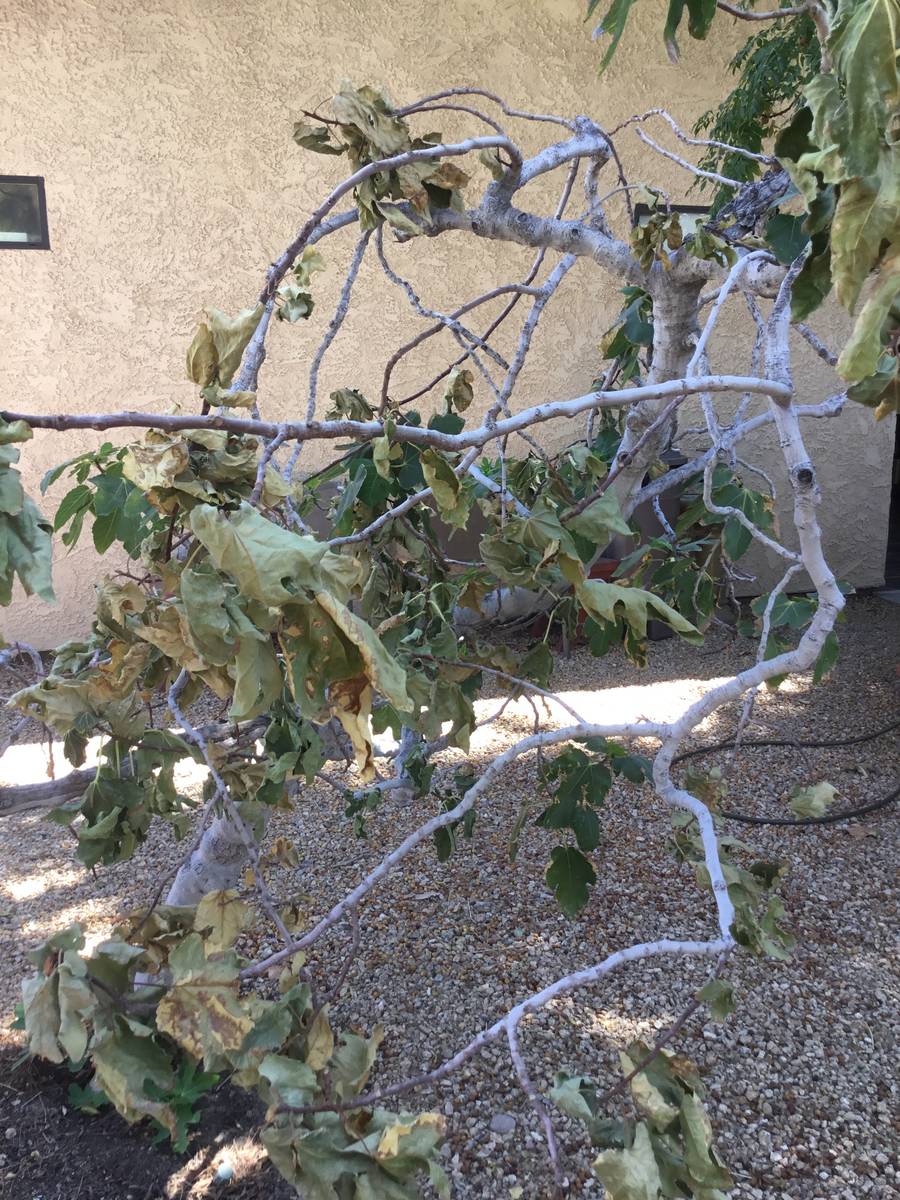Water plants if it’s a hot, bright, windy day
High temperatures this past summer really did a number on many trees, shrubs and other plants growing in the valley. Was it because of the high temperatures or not? Maybe and maybe not, it just depends. Here’s why.
Most of the damage done to plants during high summer temperatures was due to a lack of water. As trees and shrubs get larger, their need for water increases. As the temperature gets higher, and if there are strong winds, they also use more water. The bottom line, if it’s a hot, bright, windy day, it’s time to water now.
The three factors that drive plant water use greater is high light intensity (i.e., cloudless days), strong wind and high temperatures. The real kicker that drives plant water use higher day to day is the wind.
When you go outside, notice if it’s sunny or overcast. Secondly, notice if it’s windy or not. Thirdly, notice if it’s hot. When all three things come together (particularly wind), it’s time to water even if the controller isn’t scheduled to water for another day or two. Go to your controller and manually turn the irrigation on.
All it takes in this desert heat and low humidity is a few hours without water and leaves turn brown the next day and may drop. One more day without water and leaves turn brown, drop and small branches die. Two weeks without water and only desert plants survive.
The signs that plants need water are brown leaves, branch dieback and slowing or no growth. As soon as the wind or high temperatures let up, nondesert trees push new growth further inside the canopy. This new growth comes from parts of trees and shrubs that weren’t drought-stressed as much.
Water trees and shrubs deep and less often. Soils dry out at the surface first and then dry out progressively deeper and deeper if they don’t become wet from an irrigation. This means tree roots will grow in the deeper, moist soils they encounter in the soil and won’t grow in the dry soils near the soil surface. For trees and shrubs growing in the desert, you want the soil in the top few inches to become drier because this forces tree and shrub roots to grow deeper.
There are other reasons trees, shrubs and landscape plants have brown leaves and don’t look good. But you should eliminate drought from this possible mix first. Water brown plants with a hose and sprinkler on a mechanical timer for one hour, once a week along with normal irrigations, before jumping to the conclusion that they should be removed or replaced. Giving these plants supplemental water weekly for three weeks makes your decision of removal or replacement versus encouraging plant recovery easier.
Q: I found grubs in the soil with many established plants. Are these just a seasonal thing? How do I get rid of them now and prevent them in the future? Are some plants more susceptible than others?
A: I will tell you as much as I know about them. Their adult form is a large flying beetle called a chafer or June beetle that you see in June and July. Their immature form is a white grub that feeds on dead organic matter in the soil but I think also will chew on tender roots of plants like Lantana.
A few of them munching away on some plant roots here and there causes little plant damage. In fact, you won’t even know they are there. It’s when several feeding on the roots of one small plant or your landscape is inundated with them that you start to see plants struggling or even dying. So, unless there is a problem, I would leave them alone.
There are biological control pesticides such as bacteria (several commercial names of products available such as Grub Control) and nematodes (mostly online sales) that you can use in place of conventional insecticides like Sevin. They may take a year or two to get fully established in the soil.
Q: I have taken over my desert landscape maintenance, which was formerly serviced by a landscape maintenance company. Can you please provide a general monthly schedule for fertilizing, pruning, seasonal changes in watering, etc.?
A: When I consult with people on managing their landscapes at their homes, I encourage them to pay a little extra and use certified arborists for pruning ornamental trees and large shrubs. They are good at that. Only highly skilled gardeners are good at pruning fruit trees, roses and other flowering shrubs. These people are harder to find. I may be able to help you find one.
“Blow and go” maintenance companies should not be allowed to do any pruning on your property unless they can demonstrate that they know how to correctly prune your plants. Hedge shears are commonly used for pruning shrubs and other ornamentals, which makes them look all the same — gumdrops.
This type of pruning frequently removes flowers on flowering shrubs before they have a chance to display. Hedge shears should only be used to prune hedges. Many of these types of companies are good at pruning hedges but not other landscape plants.
I sent you a month-to-month calendar of operations, but it’s too long to include here so I will post a more extensive list on my blog. Watering is the most important management practice in the desert. I discuss how to water landscape plants on my blog and some tools that would help you determine when and how much to water.
Water should be applied so that it wets the soil under the entire canopy of the plant. The amount of water applied is determined by plant size. For large trees, water 36 inches deep; medium-sized trees, 24 inches deep; small trees and large shrubs, 18 inches deep.
Fertilizers for trees and shrubs are applied once a year in early spring and only when plants need it. Flowering plants are fertilized just before they flower and some, like roses, are also lightly fertilized three or four times per year.
Q: Our lime and lemon trees are doing well and growing taller, but we only had two tiny limes and no lemons this year to pick. The tags on the trees say they do not need pollinators to set fruit and we do not recall a freeze this last spring. Why didn’t we get much fruit?
A: First off, they’re not very old. Don’t expect young trees to bear much fruit until they get older. Fruit trees will produce more fruit each year as they get older.
There is a difference between a pollinator and a pollenizer. Pollinator means a second tree of a different variety needed for fruit set. Pollenizers are insects that transfer the male pollen to the female ovaries. Typical pollenizers are often honeybees, but wild bees as well, some types of flies, and even some types of moths can act as pollenizers.
All citrus need pollenizers, but they don’t need pollinators. Your fruit tag is correct in saying that they don’t need a pollinator, but all fruit trees need pollenizers.
Citrus does not survive or produce fruit consistently in the Las Vegas Valley. Citrus has two strikes against them here which warmer desert climates like Yuma, Arizona (a citrus production area), doesn’t have to worry about: cold winter temperatures that can drop below freezing (sometimes as low as the teens) and late freezes that occur regularly during January and February, exactly when several types of citrus are flowering.
Citrus are subtropical and damaged during winter cold weather and lose fruit if there are spring freezing temperatures. In our climate, your tree will have good years and bad years.
If there are freezing temperatures in the spring, you will have spotty production of fruit. If it’s a warm spring with no freezing temperatures then you will have good fruit set provided there were flowers.
If you saw no flowers on your trees, there will be no fruit. When you see flowers, make sure that you also see some honeybees. To attract honeybees to your yard, plant rosemary or other herbs that flower during the winter and attract honeybees.
Put out a tray of water and change the water weekly to keep it clean. Water also attracts honeybees but flowering plants in the winter are better.
Bob Morris is a horticulture expert and professor emeritus of the University of Nevada, Las Vegas. Visit his blog at xtremehorticulture.blogspot.com. Send questions to Extremehort@aol.com.























